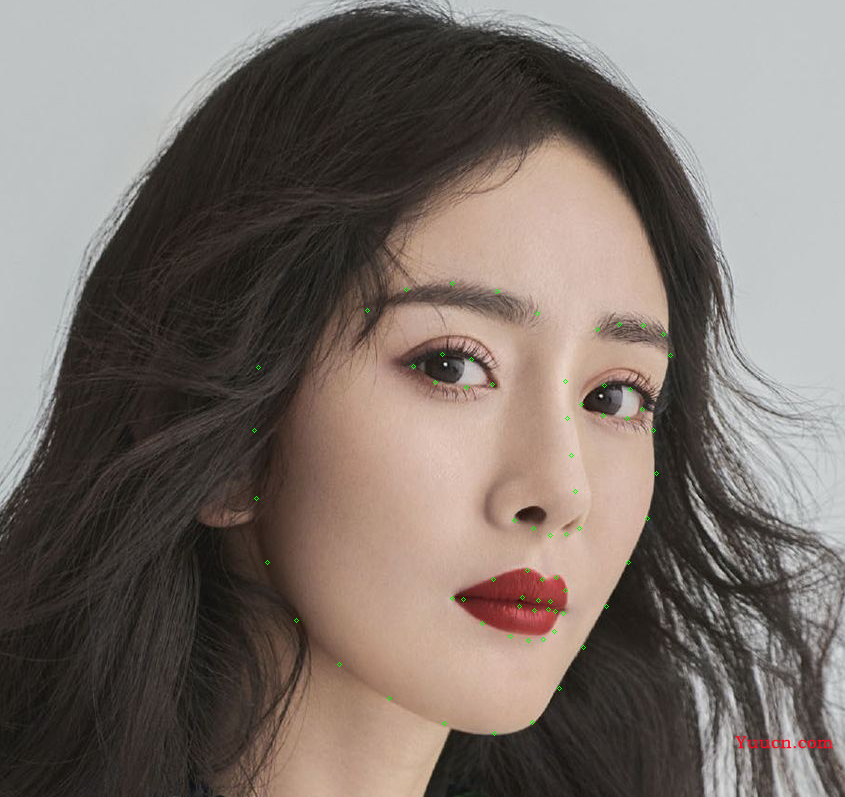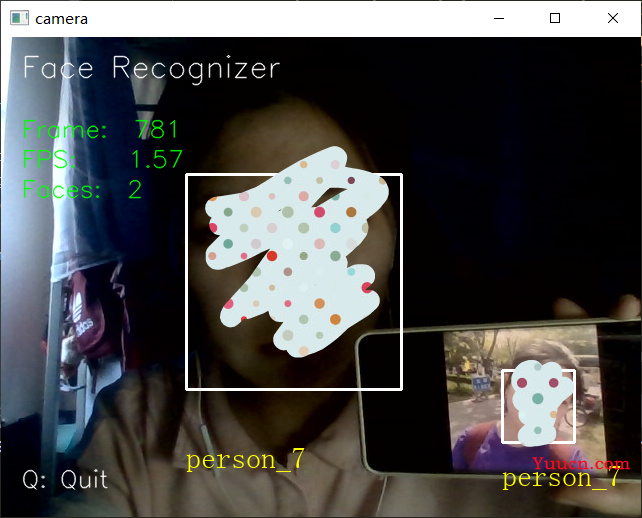目录
一、准备工作
1.1 需要的库
1.2准备需要的文件和图片
1.3 测试程序
二、人脸识别开发
2.1 录入自己的人脸信息
2.2 提取录入的人脸特征
2.3 实时捕获人脸并进行识别
三、活体检测
3.1 眨眼检测
3.2 张嘴检测
3.3 摇头检测
下面这些是我突发奇想想做来玩玩,就在github上下载了人脸识别的代码(网址下面有附上),用了之后突然想试试照片的识别效果,发现照片也会被识别成我,就查阅了相关资料,一般都是通过活体检测(比如眨眼、转头之类的),想通过算法实现实时视频检测,区分真人和照片。
一、准备工作
开发环境:windows10+pycharm2022.1.3+python+3.9
1.1 需要的库
opencv-python==4.5.5.64
numpy==1.23.3
dlib==19.24.0
pandas=1.5.0
枕头=9.2.0
dlib库安装方法:
进入虚拟环境后输入:
anaconda search -t conda dlib
conda install -c https://conda.anaconda.org/conda-forge dlib
1.2准备需要的文件和图片
进入网址:http://dlib.net/files/
下载文件:shape_predictor_68_face_landmarks.dat.bz2,解压后存在data文件夹,该模型可以识别人脸68个关键点。网址中还含有5关键点模型文件。
准备人脸照片,存于img文件夹。
1.3 测试程序
# -*- coding = utf-8 -*-
# @Time : 2022/9/20 9:11
# @Author : 李昊芸
# @file : dlib_t.py
# @Software : PyCharm
import cv2
import dlib
path = "img/lhy_1.jpeg"
img = cv2.imread(path)
gray = cv2.cvtColor(img, cv2.COLOR_BGR2GRAY)
#人脸分类器
detector = dlib.get_frontal_face_detector()
# 获取人脸检测器
predictor = dlib.shape_predictor(
".\\data\\shape_predictor_68_face_landmarks.dat"
)
dets = detector(gray, 1)
for face in dets:
shape = predictor(img, face) # 寻找人脸的68个标定点
# 遍历所有点,打印出其坐标,并圈出来
for pt in shape.parts():
pt_pos = (pt.x, pt.y)
cv2.circle(img, pt_pos, 2, (0, 255, 0), 1)
cv2.imshow("image", img)
cv2.waitKey(0)
cv2.destroyAllWindows()68关键点分类器识别结果:

多人识别效果:

二、人脸识别开发
原github地址:https://github.com/coneypo/Dlib_face_recognition_from_camera
2.1 录入自己的人脸信息
get_faces_from_camera.py
# Copyright (C) 2018-2021 coneypo
# SPDX-License-Identifier: MIT
# Author: coneypo
# Blog: http://www.cnblogs.com/AdaminXie
# GitHub: https://github.com/coneypo/Dlib_face_recognition_from_camera
# Mail: coneypo@foxmail.com
# 进行人脸录入 / Face register
import dlib
import numpy as np
import cv2
import os
import shutil
import time
import logging
# Dlib 正向人脸检测器 / Use frontal face detector of Dlib
detector = dlib.get_frontal_face_detector()
class Face_Register:
def __init__(self):
self.path_photos_from_camera = "data/data_faces_from_camera/"
self.font = cv2.FONT_ITALIC
self.existing_faces_cnt = 0 # 已录入的人脸计数器 / cnt for counting saved faces
self.ss_cnt = 0 # 录入 personX 人脸时图片计数器 / cnt for screen shots
self.current_frame_faces_cnt = 0 # 录入人脸计数器 / cnt for counting faces in current frame
self.save_flag = 1 # 之后用来控制是否保存图像的 flag / The flag to control if save
self.press_n_flag = 0 # 之后用来检查是否先按 'n' 再按 's' / The flag to check if press 'n' before 's'
# FPS
self.frame_time = 0
self.frame_start_time = 0
self.fps = 0
self.fps_show = 0
self.start_time = time.time()
# 新建保存人脸图像文件和数据 CSV 文件夹 / Mkdir for saving photos and csv
def pre_work_mkdir(self):
# 新建文件夹 / Create folders to save face images and csv
if os.path.isdir(self.path_photos_from_camera):
pass
else:
os.mkdir(self.path_photos_from_camera)
# 删除之前存的人脸数据文件夹 / Delete old face folders
def pre_work_del_old_face_folders(self):
# 删除之前存的人脸数据文件夹, 删除 "/data_faces_from_camera/person_x/"...
folders_rd = os.listdir(self.path_photos_from_camera)
for i in range(len(folders_rd)):
shutil.rmtree(self.path_photos_from_camera+folders_rd[i])
if os.path.isfile("data/features_all.csv"):
os.remove("data/features_all.csv")
# 如果有之前录入的人脸, 在之前 person_x 的序号按照 person_x+1 开始录入 / Start from person_x+1
def check_existing_faces_cnt(self):
if os.listdir("data/data_faces_from_camera/"):
# 获取已录入的最后一个人脸序号 / Get the order of latest person
person_list = os.listdir("data/data_faces_from_camera/")
person_num_list = []
for person in person_list:
person_num_list.append(int(person.split('_')[-1]))
self.existing_faces_cnt = max(person_num_list)
# 如果第一次存储或者没有之前录入的人脸, 按照 person_1 开始录入 / Start from person_1
else:
self.existing_faces_cnt = 0
# 更新 FPS / Update FPS of Video stream
def update_fps(self):
now = time.time()
# 每秒刷新 fps / Refresh fps per second
if str(self.start_time).split(".")[0] != str(now).split(".")[0]:
self.fps_show = self.fps
self.start_time = now
self.frame_time = now - self.frame_start_time
self.fps = 1.0 / self.frame_time
self.frame_start_time = now
# 生成的 cv2 window 上面添加说明文字 / PutText on cv2 window
def draw_note(self, img_rd):
# 添加说明 / Add some notes
cv2.putText(img_rd, "Face Register", (20, 40), self.font, 1, (255, 255, 255), 1, cv2.LINE_AA)
cv2.putText(img_rd, "FPS: " + str(self.fps_show.__round__(2)), (20, 100), self.font, 0.8, (0, 255, 0), 1,
cv2.LINE_AA)
cv2.putText(img_rd, "Faces: " + str(self.current_frame_faces_cnt), (20, 140), self.font, 0.8, (0, 255, 0), 1, cv2.LINE_AA)
cv2.putText(img_rd, "N: Create face folder", (20, 350), self.font, 0.8, (255, 255, 255), 1, cv2.LINE_AA)
cv2.putText(img_rd, "S: Save current face", (20, 400), self.font, 0.8, (255, 255, 255), 1, cv2.LINE_AA)
cv2.putText(img_rd, "Q: Quit", (20, 450), self.font, 0.8, (255, 255, 255), 1, cv2.LINE_AA)
# 获取人脸 / Main process of face detection and saving
def process(self, stream):
# 1. 新建储存人脸图像文件目录 / Create folders to save photos
self.pre_work_mkdir()
# 2. 删除 "/data/data_faces_from_camera" 中已有人脸图像文件
# / Uncomment if want to delete the saved faces and start from person_1
# if os.path.isdir(self.path_photos_from_camera):
# self.pre_work_del_old_face_folders()
# 3. 检查 "/data/data_faces_from_camera" 中已有人脸文件
self.check_existing_faces_cnt()
while stream.isOpened():
flag, img_rd = stream.read() # Get camera video stream
kk = cv2.waitKey(1)
faces = detector(img_rd, 0) # Use Dlib face detector
# 4. 按下 'n' 新建存储人脸的文件夹 / Press 'n' to create the folders for saving faces
if kk == ord('n'):
self.existing_faces_cnt += 1
current_face_dir = self.path_photos_from_camera + "person_" + str(self.existing_faces_cnt)
os.makedirs(current_face_dir)
logging.info("\n%-40s %s", "新建的人脸文件夹 / Create folders:", current_face_dir)
self.ss_cnt = 0 # 将人脸计数器清零 / Clear the cnt of screen shots
self.press_n_flag = 1 # 已经按下 'n' / Pressed 'n' already
# 5. 检测到人脸 / Face detected
if len(faces) != 0:
# 矩形框 / Show the ROI of faces
for k, d in enumerate(faces):
# 计算矩形框大小 / Compute the size of rectangle box
height = (d.bottom() - d.top())
width = (d.right() - d.left())
hh = int(height/2)
ww = int(width/2)
# 6. 判断人脸矩形框是否超出 480x640 / If the size of ROI > 480x640
if (d.right()+ww) > 640 or (d.bottom()+hh > 480) or (d.left()-ww < 0) or (d.top()-hh < 0):
cv2.putText(img_rd, "OUT OF RANGE", (20, 300), self.font, 0.8, (0, 0, 255), 1, cv2.LINE_AA)
color_rectangle = (0, 0, 255)
save_flag = 0
if kk == ord('s'):
logging.warning("请调整位置 / Please adjust your position")
else:
color_rectangle = (255, 255, 255)
save_flag = 1
cv2.rectangle(img_rd,
tuple([d.left() - ww, d.top() - hh]),
tuple([d.right() + ww, d.bottom() + hh]),
color_rectangle, 2)
# 7. 根据人脸大小生成空的图像 / Create blank image according to the size of face detected
img_blank = np.zeros((int(height*2), width*2, 3), np.uint8)
if save_flag:
# 8. 按下 's' 保存摄像头中的人脸到本地 / Press 's' to save faces into local images
if kk == ord('s'):
# 检查有没有先按'n'新建文件夹 / Check if you have pressed 'n'
if self.press_n_flag:
self.ss_cnt += 1
for ii in range(height*2):
for jj in range(width*2):
img_blank[ii][jj] = img_rd[d.top()-hh + ii][d.left()-ww + jj]
cv2.imwrite(current_face_dir + "/img_face_" + str(self.ss_cnt) + ".jpg", img_blank)
logging.info("%-40s %s/img_face_%s.jpg", "写入本地 / Save into:",
str(current_face_dir), str(self.ss_cnt))
else:
logging.warning("请先按 'N' 来建文件夹, 按 'S' / Please press 'N' and press 'S'")
self.current_frame_faces_cnt = len(faces)
# 9. 生成的窗口添加说明文字 / Add note on cv2 window
self.draw_note(img_rd)
# 10. 按下 'q' 键退出 / Press 'q' to exit
if kk == ord('q'):
break
# 11. Update FPS
self.update_fps()
cv2.namedWindow("camera", 1)
cv2.imshow("camera", img_rd)
def run(self):
# cap = cv2.VideoCapture("video.mp4") # Get video stream from video file
cap = cv2.VideoCapture(0) # Get video stream from camera
self.process(cap)
cap.release()
cv2.destroyAllWindows()
def main():
logging.basicConfig(level=logging.INFO)
Face_Register_con = Face_Register()
Face_Register_con.run()
if __name__ == '__main__':
main()2.2 提取录入的人脸特征
features_extraction_to_csv.py
# Copyright (C) 2018-2021 coneypo
# SPDX-License-Identifier: MIT
# Author: coneypo
# Blog: http://www.cnblogs.com/AdaminXie
# GitHub: https://github.com/coneypo/Dlib_face_recognition_from_camera
# Mail: coneypo@foxmail.com
# 从人脸图像文件中提取人脸特征存入 "features_all.csv" / Extract features from images and save into "features_all.csv"
import os
import dlib
import csv
import numpy as np
import logging
import cv2
# 要读取人脸图像文件的路径 / Path of cropped faces
path_images_from_camera = "data/data_faces_from_camera/"
# Dlib 正向人脸检测器 / Use frontal face detector of Dlib
detector = dlib.get_frontal_face_detector()
# Dlib 人脸 landmark 特征点检测器 / Get face landmarks
predictor = dlib.shape_predictor('data/data_dlib/shape_predictor_68_face_landmarks.dat')
# Dlib Resnet 人脸识别模型,提取 128D 的特征矢量 / Use Dlib resnet50 model to get 128D face descriptor
face_reco_model = dlib.face_recognition_model_v1("data/data_dlib/dlib_face_recognition_resnet_model_v1.dat")
# 返回单张图像的 128D 特征 / Return 128D features for single image
# Input: path_img <class 'str'>
# Output: face_descriptor <class 'dlib.vector'>
def return_128d_features(path_img):
img_rd = cv2.imread(path_img)
faces = detector(img_rd, 1)
logging.info("%-40s %-20s", "检测到人脸的图像 / Image with faces detected:", path_img)
# 因为有可能截下来的人脸再去检测,检测不出来人脸了, 所以要确保是 检测到人脸的人脸图像拿去算特征
# For photos of faces saved, we need to make sure that we can detect faces from the cropped images
if len(faces) != 0:
shape = predictor(img_rd, faces[0])
face_descriptor = face_reco_model.compute_face_descriptor(img_rd, shape)
else:
face_descriptor = 0
logging.warning("no face")
return face_descriptor
# 返回 personX 的 128D 特征均值 / Return the mean value of 128D face descriptor for person X
# Input: path_face_personX <class 'str'>
# Output: features_mean_personX <class 'numpy.ndarray'>
def return_features_mean_personX(path_face_personX):
features_list_personX = []
photos_list = os.listdir(path_face_personX)
if photos_list:
for i in range(len(photos_list)):
# 调用 return_128d_features() 得到 128D 特征 / Get 128D features for single image of personX
logging.info("%-40s %-20s", "正在读的人脸图像 / Reading image:", path_face_personX + "/" + photos_list[i])
features_128d = return_128d_features(path_face_personX + "/" + photos_list[i])
# 遇到没有检测出人脸的图片跳过 / Jump if no face detected from image
if features_128d == 0:
i += 1
else:
features_list_personX.append(features_128d)
else:
logging.warning("文件夹内图像文件为空 / Warning: No images in%s/", path_face_personX)
# 计算 128D 特征的均值 / Compute the mean
# personX 的 N 张图像 x 128D -> 1 x 128D
if features_list_personX:
features_mean_personX = np.array(features_list_personX, dtype=object).mean(axis=0)
else:
features_mean_personX = np.zeros(128, dtype=object, order='C')
return features_mean_personX
def main():
logging.basicConfig(level=logging.INFO)
# 获取已录入的最后一个人脸序号 / Get the order of latest person
person_list = os.listdir("data/data_faces_from_camera/")
person_list.sort()
with open("data/features_all.csv", "w", newline="") as csvfile:
writer = csv.writer(csvfile)
for person in person_list:
# Get the mean/average features of face/personX, it will be a list with a length of 128D
logging.info("%sperson_%s", path_images_from_camera, person)
features_mean_personX = return_features_mean_personX(path_images_from_camera + person)
if len(person.split('_', 2)) == 2:
# "person_x"
person_name = person
else:
# "person_x_tom"
person_name = person.split('_', 2)[-1]
features_mean_personX = np.insert(features_mean_personX, 0, person_name, axis=0)
# features_mean_personX will be 129D, person name + 128 features
writer.writerow(features_mean_personX)
logging.info('\n')
logging.info("所有录入人脸数据存入 / Save all the features of faces registered into: data/features_all.csv")
if __name__ == '__main__':
main()2.3 实时捕获人脸并进行识别
face_reco_from_camera.py
# Copyright (C) 2018-2021 coneypo
# SPDX-License-Identifier: MIT
# Author: coneypo
# Blog: http://www.cnblogs.com/AdaminXie
# GitHub: https://github.com/coneypo/Dlib_face_recognition_from_camera
# Mail: coneypo@foxmail.com
# 摄像头实时人脸识别 / Real-time face detection and recognition
import dlib
import numpy as np
import cv2
import pandas as pd
import os
import time
import logging
from PIL import Image, ImageDraw, ImageFont
# Dlib 正向人脸检测器 / Use frontal face detector of Dlib
detector = dlib.get_frontal_face_detector()
# Dlib 人脸 landmark 特征点检测器 / Get face landmarks
predictor = dlib.shape_predictor('data/data_dlib/shape_predictor_68_face_landmarks.dat')
# Dlib Resnet 人脸识别模型,提取 128D 的特征矢量 / Use Dlib resnet50 model to get 128D face descriptor
face_reco_model = dlib.face_recognition_model_v1("data/data_dlib/dlib_face_recognition_resnet_model_v1.dat")
class Face_Recognizer:
def __init__(self):
self.face_feature_known_list = [] # 用来存放所有录入人脸特征的数组 / Save the features of faces in database
self.face_name_known_list = [] # 存储录入人脸名字 / Save the name of faces in database
self.current_frame_face_cnt = 0 # 存储当前摄像头中捕获到的人脸数 / Counter for faces in current frame
self.current_frame_face_feature_list = [] # 存储当前摄像头中捕获到的人脸特征 / Features of faces in current frame
self.current_frame_face_name_list = [] # 存储当前摄像头中捕获到的所有人脸的名字 / Names of faces in current frame
self.current_frame_face_name_position_list = [] # 存储当前摄像头中捕获到的所有人脸的名字坐标 / Positions of faces in current frame
# Update FPS
self.fps = 0 # FPS of current frame
self.fps_show = 0 # FPS per second
self.frame_start_time = 0
self.frame_cnt = 0
self.start_time = time.time()
self.font = cv2.FONT_ITALIC
self.font_chinese = ImageFont.truetype("simsun.ttc", 30)
# 从 "features_all.csv" 读取录入人脸特征 / Read known faces from "features_all.csv"
def get_face_database(self):
if os.path.exists("data/features_all.csv"):
path_features_known_csv = "data/features_all.csv"
csv_rd = pd.read_csv(path_features_known_csv, header=None)
for i in range(csv_rd.shape[0]):
features_someone_arr = []
self.face_name_known_list.append(csv_rd.iloc[i][0])
for j in range(1, 129):
if csv_rd.iloc[i][j] == '':
features_someone_arr.append('0')
else:
features_someone_arr.append(csv_rd.iloc[i][j])
self.face_feature_known_list.append(features_someone_arr)
logging.info("Faces in Database:%d", len(self.face_feature_known_list))
return 1
else:
logging.warning("'features_all.csv' not found!")
logging.warning("Please run 'get_faces_from_camera.py' "
"and 'features_extraction_to_csv.py' before 'face_reco_from_camera.py'")
return 0
# 计算两个128D向量间的欧式距离 / Compute the e-distance between two 128D features
@staticmethod
def return_euclidean_distance(feature_1, feature_2):
feature_1 = np.array(feature_1)
feature_2 = np.array(feature_2)
dist = np.sqrt(np.sum(np.square(feature_1 - feature_2)))
return dist
# 更新 FPS / Update FPS of Video stream
def update_fps(self):
now = time.time()
# 每秒刷新 fps / Refresh fps per second
if str(self.start_time).split(".")[0] != str(now).split(".")[0]:
self.fps_show = self.fps
self.start_time = now
self.frame_time = now - self.frame_start_time
self.fps = 1.0 / self.frame_time
self.frame_start_time = now
# 生成的 cv2 window 上面添加说明文字 / PutText on cv2 window
def draw_note(self, img_rd):
cv2.putText(img_rd, "Face Recognizer", (20, 40), self.font, 1, (255, 255, 255), 1, cv2.LINE_AA)
cv2.putText(img_rd, "Frame: " + str(self.frame_cnt), (20, 100), self.font, 0.8, (0, 255, 0), 1,
cv2.LINE_AA)
cv2.putText(img_rd, "FPS: " + str(self.fps_show.__round__(2)), (20, 130), self.font, 0.8, (0, 255, 0), 1,
cv2.LINE_AA)
cv2.putText(img_rd, "Faces: " + str(self.current_frame_face_cnt), (20, 160), self.font, 0.8, (0, 255, 0), 1,
cv2.LINE_AA)
cv2.putText(img_rd, "Q: Quit", (20, 450), self.font, 0.8, (255, 255, 255), 1, cv2.LINE_AA)
def draw_name(self, img_rd):
# 在人脸框下面写人脸名字 / Write names under rectangle
img = Image.fromarray(cv2.cvtColor(img_rd, cv2.COLOR_BGR2RGB))
draw = ImageDraw.Draw(img)
for i in range(self.current_frame_face_cnt):
# cv2.putText(img_rd, self.current_frame_face_name_list[i], self.current_frame_face_name_position_list[i], self.font, 0.8, (0, 255, 255), 1, cv2.LINE_AA)
draw.text(xy=self.current_frame_face_name_position_list[i], text=self.current_frame_face_name_list[i], font=self.font_chinese,
fill=(255, 255, 0))
img_rd = cv2.cvtColor(np.array(img), cv2.COLOR_RGB2BGR)
return img_rd
# 修改显示人名 / Show names in chinese
def show_chinese_name(self):
# Default known name: person_1, person_2, person_3
if self.current_frame_face_cnt >= 1:
# 修改录入的人脸姓名 / Modify names in face_name_known_list to chinese name
self.face_name_known_list[0] = '张三'.encode('utf-8').decode()
# self.face_name_known_list[1] = '张四'.encode('utf-8').decode()
# 处理获取的视频流,进行人脸识别 / Face detection and recognition from input video stream
def process(self, stream):
# 1. 读取存放所有人脸特征的 csv / Read known faces from "features.all.csv"
if self.get_face_database():
while stream.isOpened():
self.frame_cnt += 1
logging.debug("Frame %d starts", self.frame_cnt)
flag, img_rd = stream.read()
faces = detector(img_rd, 0)
kk = cv2.waitKey(1)
# 按下 q 键退出 / Press 'q' to quit
if kk == ord('q'):
break
else:
self.draw_note(img_rd)
self.current_frame_face_feature_list = []
self.current_frame_face_cnt = 0
self.current_frame_face_name_position_list = []
self.current_frame_face_name_list = []
# 2. 检测到人脸 / Face detected in current frame
if len(faces) != 0:
# 3. 获取当前捕获到的图像的所有人脸的特征 / Compute the face descriptors for faces in current frame
for i in range(len(faces)):
shape = predictor(img_rd, faces[i])
self.current_frame_face_feature_list.append(face_reco_model.compute_face_descriptor(img_rd, shape))
# 4. 遍历捕获到的图像中所有的人脸 / Traversal all the faces in the database
for k in range(len(faces)):
logging.debug("For face %d in camera:", k+1)
# 先默认所有人不认识,是 unknown / Set the default names of faces with "unknown"
self.current_frame_face_name_list.append("unknown")
# 每个捕获人脸的名字坐标 / Positions of faces captured
self.current_frame_face_name_position_list.append(tuple(
[faces[k].left(), int(faces[k].bottom() + (faces[k].bottom() - faces[k].top()) / 4)]))
# 5. 对于某张人脸,遍历所有存储的人脸特征
# For every faces detected, compare the faces in the database
current_frame_e_distance_list = []
for i in range(len(self.face_feature_known_list)):
# 如果 person_X 数据不为空
if str(self.face_feature_known_list[i][0]) != '0.0':
e_distance_tmp = self.return_euclidean_distance(self.current_frame_face_feature_list[k],
self.face_feature_known_list[i])
logging.debug(" With person %s, the e-distance is %f", str(i + 1), e_distance_tmp)
current_frame_e_distance_list.append(e_distance_tmp)
else:
# 空数据 person_X
current_frame_e_distance_list.append(999999999)
# 6. 寻找出最小的欧式距离匹配 / Find the one with minimum e-distance
similar_person_num = current_frame_e_distance_list.index(min(current_frame_e_distance_list))
logging.debug("Minimum e-distance with %s: %f", self.face_name_known_list[similar_person_num], min(current_frame_e_distance_list))
if min(current_frame_e_distance_list) < 0.4:
self.current_frame_face_name_list[k] = self.face_name_known_list[similar_person_num]
logging.debug("Face recognition result: %s", self.face_name_known_list[similar_person_num])
else:
logging.debug("Face recognition result: Unknown person")
logging.debug("\n")
# 矩形框 / Draw rectangle
for kk, d in enumerate(faces):
# 绘制矩形框
cv2.rectangle(img_rd, tuple([d.left(), d.top()]), tuple([d.right(), d.bottom()]),
(255, 255, 255), 2)
self.current_frame_face_cnt = len(faces)
# 7. 在这里更改显示的人名 / Modify name if needed
# self.show_chinese_name()
# 8. 写名字 / Draw name
img_with_name = self.draw_name(img_rd)
else:
img_with_name = img_rd
logging.debug("Faces in camera now: %s", self.current_frame_face_name_list)
cv2.imshow("camera", img_with_name)
# 9. 更新 FPS / Update stream FPS
self.update_fps()
logging.debug("Frame ends\n\n")
# OpenCV 调用摄像头并进行 process
def run(self):
# cap = cv2.VideoCapture("video.mp4") # Get video stream from video file
cap = cv2.VideoCapture(0) # Get video stream from camera
cap.set(3, 480) # 640x480
self.process(cap)
cap.release()
cv2.destroyAllWindows()
def main():
# logging.basicConfig(level=logging.DEBUG) # Set log level to 'logging.DEBUG' to print debug info of every frame
logging.basicConfig(level=logging.INFO)
Face_Recognizer_con = Face_Recognizer()
Face_Recognizer_con.run()
if __name__ == '__main__':
main()
识别结果(我和我的无美颜照片):

(自己的脸,马赛克一下)
可以看出, 识别效果还是很不错的。
三、活体检测
3.1 眨眼检测
经过查询资料,得到广为人使用的一个指标:眼睛纵横比(EAR)
![]()
分别得到两只眼睛的纵横比并取平均值,作为眨眼的指标,经过多次测试后,选取0.3作为阈值。
在连续检测到两次EAR小于阈值,即眼睛一睁一闭时,我们将记录为一次眨眼。
代码如下,实验结果如图:

from scipy.spatial import distance as dist
from imutils.video import VideoStream
from imutils import face_utils
import imutils
import time
import dlib
import cv2
def EAR(eye):
# 计算眼睛的两组垂直关键点之间的欧式距离
A = dist.euclidean(eye[1], eye[5]) # 1,5是一组垂直关键点
B = dist.euclidean(eye[2], eye[4]) # 2,4是一组
# 计算眼睛的一组水平关键点之间的欧式距离
C = dist.euclidean(eye[0], eye[3]) # 0,3是一组水平关键点
return (A + B) / (2.0 * C)
def main():
EAR_THRESH = 0.3 # 眨眼阈值
EYE_close = 2 # 闭眼次数阈值
# 初始化眨眼帧计数器和总眨眼次数
count_eye = 0
total = 0
detector = dlib.get_frontal_face_detector()
predictor = dlib.shape_predictor('shape_predictor_68_face_landmarks.dat')
# 左右眼的索引
(lStart, lEnd) = face_utils.FACIAL_LANDMARKS_IDXS["left_eye"]
(rStart, rEnd) = face_utils.FACIAL_LANDMARKS_IDXS["right_eye"]
vs = VideoStream(src=0).start()
time.sleep(1.0)
while True:
frame = vs.read()
frame = imutils.resize(frame, width=600)
gray = cv2.cvtColor(frame, cv2.COLOR_BGR2GRAY)
# 在灰度框中检测人脸
rects = detector(gray, 0)
# 进入循环
for rect in rects:
shape = predictor(gray, rect)
shape = face_utils.shape_to_np(shape)
# 提取左眼和右眼坐标,然后使用该坐标计算两只眼睛的眼睛纵横比
leftEye = shape[lStart:lEnd]
rightEye = shape[rStart:rEnd]
ear = EAR(leftEye) + EAR(rightEye) / 2.0
# 判断眼睛纵横比是否低于眨眼阈值
if ear < EAR_THRESH:
count_eye += 1
else:
# 检测到一次闭眼
if count_eye >= EYE_close:
total += 1
count_eye = 0
# 画出画框上眨眼的总次数以及计算出的帧的眼睛纵横比
cv2.putText(frame, "Blinks: {}".format(total), (10, 30),
cv2.FONT_HERSHEY_SIMPLEX, 0.7, (0, 0, 255), 2)
cv2.putText(frame, "EAR: {:.2f}".format(ear), (300, 30),
cv2.FONT_HERSHEY_SIMPLEX, 0.7, (0, 0, 255), 2)
cv2.imshow("Frame", frame)
key = cv2.waitKey(1) & 0xFF
if key == ord("q"):
break
cv2.destroyAllWindows()
vs.stop()
if __name__ == '__main__':
main()
3.2 张嘴检测
同理,可以做张嘴检测:

from imutils.video import VideoStream
from imutils import face_utils
import imutils
import time
import dlib
import cv2
import numpy as np
def MAR(mouth):
# 默认二范数:求特征值,然后求最大特征值得算术平方根
A = np.linalg.norm(mouth[2] - mouth[9]) # 51, 59(人脸68个关键点)
B = np.linalg.norm(mouth[4] - mouth[7]) # 53, 57
C = np.linalg.norm(mouth[0] - mouth[6]) # 49, 55
return (A + B) / (2.0 * C)
def main():
MAR_THRESH = 0.5 # 张嘴阈值
# 初始化
COUNTER_MOUTH = 0
TOTAL_MOUTH = 0
detector = dlib.get_frontal_face_detector()
predictor = dlib.shape_predictor('shape_predictor_68_face_landmarks.dat')
# 嘴的索引
(mStart, mEnd) = face_utils.FACIAL_LANDMARKS_IDXS["mouth"]
vs = VideoStream(src=0).start()
time.sleep(1.0)
while True:
frame = vs.read()
frame = imutils.resize(frame, width=600)
gray = cv2.cvtColor(frame, cv2.COLOR_BGR2GRAY)
# 在灰度框中检测人脸
rects = detector(gray, 0)
# 进入循环
for rect in rects:
shape = predictor(gray, rect)
shape = face_utils.shape_to_np(shape)
# 提取嘴唇坐标,然后使用该坐标计算嘴唇纵横比
Mouth = shape[mStart:mEnd]
mar = MAR(Mouth)
# 判断嘴唇纵横比是否高于张嘴阈值,如果是,则增加张嘴帧计数器
if mar > MAR_THRESH:
COUNTER_MOUTH += 1
else:
# 如果张嘴帧计数器不等于0,则增加张嘴的总次数
if COUNTER_MOUTH >= 2:
TOTAL_MOUTH += 1
COUNTER_MOUTH = 0
cv2.putText(frame, "Mouth is open: {}".format(TOTAL_MOUTH), (10, 60),
cv2.FONT_HERSHEY_SIMPLEX, 0.7, (0, 0, 255), 2)
cv2.putText(frame, "MAR: {:.2f}".format(mar), (300, 60),
cv2.FONT_HERSHEY_SIMPLEX, 0.7, (0, 0, 255), 2)
cv2.imshow("Frame", frame)
key = cv2.waitKey(1) & 0xFF
if key == ord("q"):
break
cv2.destroyAllWindows()
vs.stop()
if __name__ == '__main__':
main()3.3 摇头检测
在手机很多App如支付宝中,摇头也属于非常常见的活体检测手段,此项采用鼻子到左右脸的欧氏距离变化,判断是否摇头。

代码如下:
from scipy.spatial import distance as dist
from imutils.video import VideoStream
from imutils import face_utils
import imutils
import time
import dlib
import cv2
def nose_jaw_distance(nose, jaw):
# 计算鼻子上一点"27"到左右脸边界的欧式距离
face_left1 = dist.euclidean(nose[0], jaw[0]) # 27, 0
face_right1 = dist.euclidean(nose[0], jaw[16]) # 27, 16
# 计算鼻子上一点"30"到左右脸边界的欧式距离
face_left2 = dist.euclidean(nose[3], jaw[2]) # 30, 2
face_right2 = dist.euclidean(nose[3], jaw[14]) # 30, 14
# 创建元组,用以保存4个欧式距离值
face_distance = (face_left1, face_right1, face_left2, face_right2)
return face_distance
def main():
# 初始化眨眼帧计数器和总眨眼次数
distance_left = 0
distance_right = 0
TOTAL_FACE = 0
detector = dlib.get_frontal_face_detector()
predictor = dlib.shape_predictor('shape_predictor_68_face_landmarks.dat')
(nStart, nEnd) = face_utils.FACIAL_LANDMARKS_IDXS["nose"]
(jStart, jEnd) = face_utils.FACIAL_LANDMARKS_IDXS['jaw']
vs = VideoStream(src=0).start()
time.sleep(1.0)
while True:
frame = vs.read()
frame = imutils.resize(frame, width=600)
gray = cv2.cvtColor(frame, cv2.COLOR_BGR2GRAY)
# 在灰度框中检测人脸
rects = detector(gray, 0)
# 进入循环
for rect in rects:
shape = predictor(gray, rect)
shape = face_utils.shape_to_np(shape)
# 提取鼻子和下巴的坐标,然后使用该坐标计算鼻子到左右脸边界的欧式距离
nose = shape[nStart:nEnd]
jaw = shape[jStart:jEnd]
NOSE_JAW_Distance = nose_jaw_distance(nose, jaw)
# 移植鼻子到左右脸边界的欧式距离
face_left1 = NOSE_JAW_Distance[0]
face_right1 = NOSE_JAW_Distance[1]
face_left2 = NOSE_JAW_Distance[2]
face_right2 = NOSE_JAW_Distance[3]
# 根据鼻子到左右脸边界的欧式距离,判断是否摇头
# 左脸大于右脸
if face_left1 >= face_right1 + 2 and face_left2 >= face_right2 + 2:
distance_left += 1
# 右脸大于左脸
if face_right1 >= face_left1 + 2 and face_right2 >= face_left2 + 2:
distance_right += 1
# 左脸大于右脸,并且右脸大于左脸,判定摇头
if distance_left != 0 and distance_right != 0:
TOTAL_FACE += 1
distance_right = 0
distance_left = 0
# 画出摇头次数
cv2.putText(frame, "shake one's head: {}".format(TOTAL_FACE), (10, 90),
cv2.FONT_HERSHEY_SIMPLEX, 0.7, (0, 0, 255), 2)
cv2.imshow("Frame", frame)
key = cv2.waitKey(1) & 0xFF
if key == ord("q"):
break
cv2.destroyAllWindows()
vs.stop()
if __name__ == '__main__':
main()